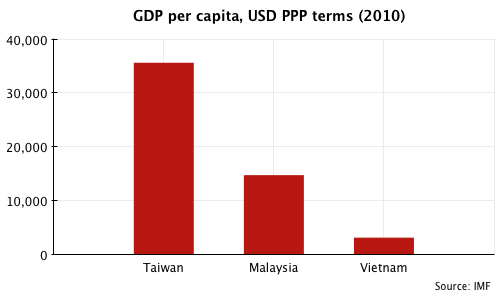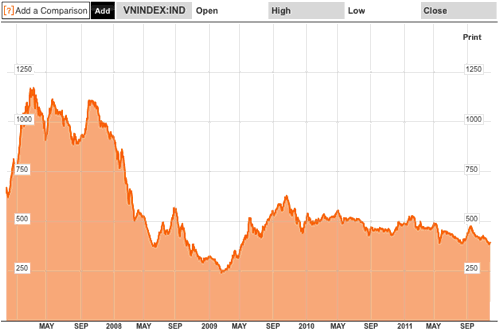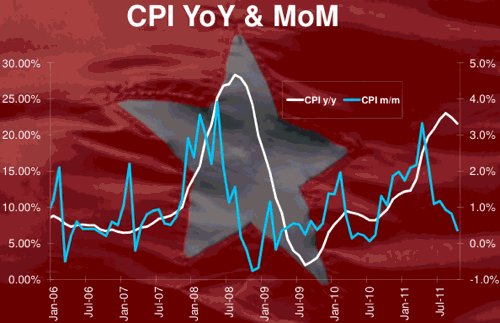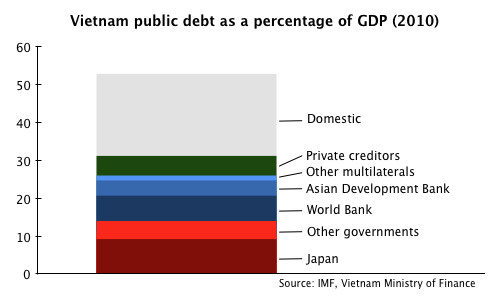Vietnam has proved to be a terrible investment over the last four years. Widely seen as the “next Asian tiger” in the middle of the decade, an article in the FT today shows how attitudes have changed. Here’s a sample:
The government’s focus on breakneck growth at the expense of economic stability has led to growing inequality, soaring inflation, a lack of confidence in the currency and fears of a banking crisis.
Domestic overheating, coupled with the deterioration of the global economy, has forced many investors, foreign and Vietnamese, to revise their view of the country’s prospects. Deep-seated problems, such as corruption, poor education and infrastructure bottlenecks – all often overlooked by investors in the boom years – have moved into sharp focus.
And with inflation driving wages higher but labour skills not advancing as quickly, fresh questions are arising. Among them is whether Vietnam’s Communist party can force through painful reforms needed to ensure they avoid the “middle-income trap” ensnaring the likes of Malaysia and Thailand, whose economies are a source of cheap labour but not yet makers of higher-value products.
It’s a good summary of some of the country’s problems, but I think it conflates two issues: the immediate outlook and the longer-term outlook. (That’s not because the writer doesn’t know what he’s talking about – he clearly does – but because of the structure of the piece.)
Vietnam is not in a middle income trap
To have any chance of developing as successfully as South Korea or Taiwan, Vietnam will eventually need to bring in many difficult reforms. But this has little to do with what it needs to do in the immediate future. The following chart may help to put the situation in context.
On the left, we have Taiwan – one of the 20th century’s great development success stories. It’s an advanced economy with a GDP per capita of $35,000 in purchasing power parity terms (ie adjusting for the different costs of goods and services between countries).
In the middle we have Malaysia, which is often used as the poster child for the middle income trap – meaning it’s developed successfully to a certain point, but structural problems (skills, infrastructure, crony capitalism) prevent it moving on from competing on skills to competing on innovation.
In fact, whether the middle income trap really exists is a matter of debate. But for the purposes of this article, let’s assume it does and that Malaysia is a good example.
Lastly, on the right we have Vietnam. And you can see that Vietnam is not just far poorer than Taiwan, but far poorer than our middle income trap proxy, Malaysia.
As this may suggest, it’s probably too early to be wondering if Vietnam will be a victim of this trap.
The history of development in Asia suggests that a country that is open to business, has acceptable geography and location, adequate skills, good stability and security, okay infrastructure and a few other criteria can get off the lowest rung of the ladder through low-cost, export-orientated manufacturing.
Vietnam qualifies on those scores and that’s the approach it’s trying to follow. But it’s still got a long way to go on that path before it can even start thinking about whether it can make the more difficult leap to being an advanced economy or whether that will be as good as it gets – as some suggest has been the case for Malaysia.
A lot of the issues that are supposed to be part of the middle income trap simply don’t apply at this stage and are certainly not Vietnam’s most pressing problems.
Vietnam’s disastrous dash for growth
The country’s current headaches – and the lamentable performance of the market since 2007 (see below) – are to do with more immediate policy mistakes.
Vietnam’s government followed a rather aggressive pro-growth policy over the last few years, keeping monetary policy easy, encouraging banks to lend and promoting the development of sprawling state-owned enterprise (SOE) conglomerates (the latter inspired by the idea that the Korean chaebol had been responsible for the country’s success).
Having kept this up too long, the country has run into a slew of predictable problems. Inflation is far too high, asset prices have gone through a bubble and bust and the SOEs have squandered a great deal on poor investments.
Loan quality in many banks is undoubtedly very poor, the trade deficit has ballooned, FX reserves are very low and confidence in the currency is minimal. It’s a mess.
The government wouldn’t admit it was on the wrong track for a long time. But its ‘growth above all’ strategy began unraveling in 2010 when Vinashin, the flagship SOE, imploded with billions of dollars in debts.
Vinashin, originally a shipbuilder, had invested heavily at the peak of the cycle, and when orders dried up after the global financial crisis, it had far more capacity than it needed. In addition, it had diversified freely, from breweries to spas and everything in between.
The Vinashin crisis seems to have marked a turning point. Rather than bailing its national champion out, the government acknowledged it had failed and began restructuring. Policymakers then began raising interest rates, ordered banks to curb speculative lending and generally began acting more responsibly.
Nobody was sure if they would stick to this, but so far they have. And at present the signs are that this will continue.
As usual, tighter policy in the aftermath of a boom is causing a great deal of pain. That explains why many in Vietnam are pretty unhappy with the economy and why most coverage of the country tends to be gloomy, as in the FT story above.
However, if the economy is going to get back on track, this kind of squeeze is inevitable. The question is whether there are any signs that the policies are having the desired effect. And here I think things are starting to look encouraging.
Inflation is coming under control
A couple of weeks ago, I met Kevin Snowball of the PXP Vietnam Fund on a marketing trip, to get his views on the outlook. The first chart he showed was the one below: Vietnamese inflation, year-over-year (white line) and month-on-month (blue line).
As you can see, headline inflation still looks very high. But that reflects the fact that prices soared earlier this year.
If you look at the month-on-month trend, it’s been decelerating for a while. In short, the pace of inflation is coming down and if this continues the headline figure will soon look much better.
The trend here is definitely encouraging. I think the other key point to watch is the currency.
When confidence in the dong is low and Vietnam investors and savers fear another devaluation, they move out of their local currency into harder assets (US dollars and gold). This obviously increases the pressure on the dong and increases the risk of devaluation, creating a vicious circle.
After a very difficult couple of years with several successive devaluations, the central bank began to get a grip again earlier this year. The gap between the official rate (pegged to the dollar) and the blackmarket rate narrowed to nothing on occasion.
Lately, the dong has weakened again – recent blackmarket rates have been around 21,400 VND/USD against the official rate of 20,803. But that’s not totally surprising, given that the US dollar is strengthening against most emerging market currencies at the moment.
However, the central bank clearly hasn’t completely restored confidence in the currency. That will probably be the next key turning point after inflation stablises. Indeed once it’s clear that inflation is under control, that alone should help support the dong.
Once both inflation and the currency are back under control, policymakers will need to show that they can stick to prudent monetary and fiscal policies from now on. If that happens, Vietnam will start to win back some of its lost credibility.
A serious crisis looks unlikely
That said, there are clearly some risks that things could unravel further. It seems pretty obvious that reported NPLs in the banking system (3.2% at the end of September) don’t reflect the real quality of the loan book and if policy remains tight, some banks will struggle.
A banking system crisis is possible – indeed, some kind of shake-up is almost certain. But if this forces restructuring, consolidation and reform in the sector, it will be for the good in the long run – and the central bank seems to be thinking along these lines.
The wide trade deficit and low FX reserves definitely aren’t reassuring at a time like this, but the situation is complex. At its stage of development, Vietnam can be expected to run a sizeable deficit as it imports capital goods.
Foreign direct investment and remittances from Vietnamese working abroad should comfortably offset this. The real problem in the balance of payments is probably Vietnamese investors swapping their dong for US dollars and gold, as mentioned above.
Once policymakers can make the dong more stable, this problem will shrink. But regaining credibility means keeping policy tight, bringing problems out into the open and making everything look worse in the short run.
One of the most difficult aspects of Vietnam’s current struggle is that it’s taking place at a time when the global economy is very fraught. The eurozone crisis means that investors look pretty poorly on anything risky – so if you want to attract investment or borrow money, it gets difficult.
That said, much of Vietnam’s investment comes from Asia – and Asian investors are still much more upbeat than Europe and the US. Disbursed foreign direct investment was reported to be US$8.2bn in the first nine months of 2011, up slightly on last year.
The fiscal position isn’t outstanding – government debt is 53% of GDP, budget deficit of 6.4% last year – but it doesn’t suggest an immediate crisis. The government says that it’s trying to improve the finances: the 2012 budget deficit target is 4.8% (although a banking sector or SOE bailout could create added liabilities).
While external debt is around 60% of government borrowings, Vietnam doesn’t seem too exposed to the risk of foreign funding drying up. The country has issued a couple of US dollar sovereign bonds – the proceeds of one were regrettably channeled straight to Vinashin – but international private creditors are only a small part of public debt. Most of its foreign exposure is to multilateral institutions – the World Bank and the Asian Development Bank – and the Japanese government.
The potential payoff looks worth the risk
Overall, my view is that if Vietnamese policymakers keep the pressure on, accept lower growth for a while and clean up the banks and SOEs as needed, the medium-term outlook is actually pretty good. Once this becomes obvious, both foreign investors and locals will move back into Vietnamese equities.
And the market looks cheap. Depending on what estimates you use, the VN Index is on around 7-9 times forecast 2011 earnings and 6-8 times forecast 2012 earnings.
There’s no doubt that the economy is going through a tough period, but stocks are priced for that. Obviously, this is a frontier market and a high-risk investment. But barring disaster, I think the market could double over the next year or two once the worst of the adjustment is out of the way, making it look worth that risk.
Buying Vietnamese shares directly takes a lot of work, so funds are the usual route for most foreign investors.
There are a couple of ETFs – db x-trackers FTSE Vietnam, with various listings, and Van Eck Market Vectors Vietnam in the US – but I don’t think trackers make much sense in this market, for a couple of reasons.
One is that there are limits on foreign ownership of Vietnamese stocks. The active funds have already bought many of the best companies up to the quota limit, meaning the ETFs are overweight in many large, poor quality stocks that the active funds don’t want to hold.
The other is that local traders know what the ETFs have to hold. And in a market like Vietnam, it’s very easily for them to front-run the smaller stocks in the index when they know the ETF will be buying, pushing up the price before selling out.
So I prefer a good managed fund and as usual I favour investment trusts/closed end funds, especially if you can buy them at a discount. There are two obvious suggestions.
The best-known option is the Vietnam Opportunity Fund, listed on the Aim board in London (LN:VOF). This holds a mix of listed equities, real estate, private equity and bonds, and is currently trading at a discount to last net asset value (NAV) of 40%.
It charges a management fee of 2% and a performance fee of 20% of gains over 8% per year. I’m normally very opposed to performance fees, but this one is subject to a high water mark and given the NAV is well below its all-time high, the performance fee isn’t going to kick in for a long time.
Another option in the PXP Vietnam Fund, mentioned earlier, listed on the main board in London (LN:VNF). This is purely a listed equity fund and trades on a discount to estimated NAV of 10%. (Obviously with a pure listed equity fund, there is more certainty of portfolio value than with one that holds unlisted investments, so the discount for this and VOF aren’t easily comparable.)
The management fee is 2% per year and there are no performance fees. This fund trades fairly infrequently, although the manager tells me that the underlying liquidity is there at the market makers for even fairly large trades.
Vietnam is definitely only a suitable investment for patient investors who are willing to take a risk. Which fund would be best is a matter of personal preference.
Personally, I prefer the PXP Vietnam Fund’s focus on listed equity and its relatively conservative approach. I have a very small investment in it, which I will probably increase if I think policymakers are still on the right track in the next few months.



